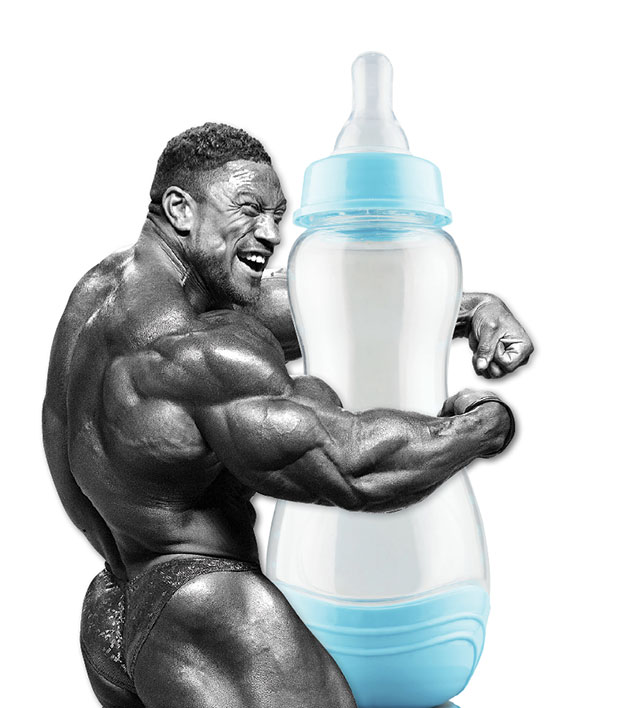Got breast milk

I must admit, when I was assigned this topic, I thought it was odd and disturbing in many ways. But, it appears there are bodybuilders out there who are actually drinking human breast milk in hopes of making greater muscle gains. Yes, that’s right, breast milk has become the latest fad to be talked about on the some of the popular bodybuilding forums.
Some guys who are desperate to try anything to put on muscle believe that breast milk can help since it contains a bunch of growth factors. Is breast milk really effective for packing on muscle? And is it more effective than other clinically proven supplements, or a protein-rich diet, for that matter? Keep reading to find out the lowdown on this latest bro science!
What’s in Breast Milk?
Breast milk is a combination of different proteins, antibodies, and growth factors. And, its nutrient content and concentration varies depending on when the breasts produce the milk. The initial milk that’s produced is called colostrum. This is a yellow fluid with a thin consistency that’s high in immunoglobulin A or IgA, which is responsible for coating and protecting the gastrointestinal system until the immune system is up and functioning. Over time, colostrum turns to mature milk, becoming thicker and creamier. This consistency is due to its increased nutrient content including proteins, sugar, antibodies, and minerals in specific ratios needed by the infant offspring.

When it comes down to specifics, breast milk delivers about 1 gram of protein, 5 grams of fat, 7 grams of carbs, and 150 milligrams of minerals per 100 millilitres. Fats are made up of triglycerides: palmitic and oleic acid and lipids of conjugated linoleic acid (CLA) and vaccenic acid.
Carbohydrates consist of mainly lactose and oligosaccardies, while protein includes casein, alpha-lactalbumin, lactoferrin, IgA, serum albumin, and lysozyme. It also contains nitrogen-containing compounds including urea, uric acid, amino acids, creatine, creatinine, and nucleotides. It also delivers endocannabinoids, the natural neurotransmitter that marijuana stimulates! Endocannabinoids can stimulate appetite the same way that marijuana gives you munchies, but they can also help regulate appetite.
Every Breast Is Different
One thing to point out about breast milk is that not every breast will give the exact same composition. The quality of breast milk depends on the quality of the mother’s diet. If she doesn’t follow a fit and healthy lifestyle, the quality of the milk will suffer. For example, a woman with diabetes will give off milk that has higher sugar and higher insulin content than a non-diabetic woman. Another thing to consider: Breast milk is a bodily fluid and can transmit environmental toxins taken up from food or exposure, medications, viruses, and bacteria! A whole lot of bacteria, actually—remember, unlike dairy milk, breast milk sure isn’t pasteurized! Breast milk delivers over 600 different species of bacteria, including some beneficial bacteria such as bifidobacterium, but also harmful bacteria including staphylococcus, streptococcous, and salmonella. Although the majority of these bacteria are found naturally in breast milk and are used to help flourish the beneficial gut bacteria in a baby’s developing gut, the bad bacteria come when the milk is left out for too long.

Nutritionally Speaking
Breast milk contains about 170 calories per cup, 10 grams of fat, 16 grams of carbs, and only 2 grams of protein, along with an assortment of vitamins and minerals, and the growth factors just discussed. Despite all the good stuff in breast milk, one thing still remains unknown: Are the nutrients in breast milk only beneficial for babies, or do the nutrients get absorbed and utilized in adults?
Research on colostrum from bovine sources that’s given to athletes has been found to be useful for increasing improving performance outcomes. One study that compared supplementing with 20 grams per day of colostrum powder with 20 grams per day of whey protein powder for 8 weeks in combination with an exercise training program showed that bovine colostrum increased lean body mass in active men and women, whereas the whey group experienced just body weight increases. In another study, a group of cyclists given low-dose bovine colostrum experienced improvements in endurance performance, intensity, and maintained heart rate during exercise.
On the other hand, research on colostrum for being effective for increasing lean mass or growth factors such as insulin-like-growth factor 1 (IGF-1) is mixed. Some studies have shown no result from supplementation, while others have shown to increase IGF-1 concentration during strength and speed training.
Although some research supports bovine colostrum for showing improvements in performance and lean mass, it doesn’t mean breast milk from a human can do the same. Breast milk is designed specifically to help a developing baby get all the nutrients it needs in the right amounts to grow. That doesn’t mean that those nutrients will survive the harsh acidic environment of an adult’s stomach and be usable by the body in any appreciable amounts.

You Get What You Pay For?
If you decide that you really want to give breast milk a try, you’ll be looking at paying about two dollars per ounce, depending on who’s selling you the milk. There have even been reports of lactating women selling “nipple time” to the highest bidder so they can get their breast milk directly from the source! Just remember, it’s not like buying a quart of pasteurized and sterilized milk at your local grocery store. Most people who are selling their milk are doing so for a particular reason and probably not a very good one. There are plenty of risks involved in using breast milk, including contracting a communicable disease such as hepatitis or HIV, or getting a serious infection from high levels of dangerous bacteria if the milk hasn’t been kept at a proper temperature. There are breast milk banks that pasteurize donated milk, but these are reserved for those who are actually in need of the breast milk for their babies, not their muscles. Breast milk isn’t worth the risk, nor has it been proven to be effective! Save your money and spend it on something that’s safe and has been clinically proven to give you results for building muscle, such as creatine, BCAAs, or betaine.
If breast milk isn't quite for you, consider using a different type! Whey may be your answer! Learn more about different types of protein here
References:
Antonia J, et al. The effect of bovine colostrum supplementation on body composition and exercise performance in active men and women. Nutrition. 2001;17(3): 243-7.
Kulpers H, et al. Effects of oral bovine colostrum supplementation on serum insulin-like growth factor-I levels. Nutrition. 2002;18(7-8): 556-67.
Mero A, et al. Effects of bovine colostrum supplementation on serum IGF-I, IgG, hormone, and saliva IgA during training. J Appl Physiol. 1997; 83(4): 1144-51.
Shing CM, et al. The influence of bovine colostrum supplementation on exercise performance in highly trained cyclists. Br J Sports Med. 2006;40: 797-801.

